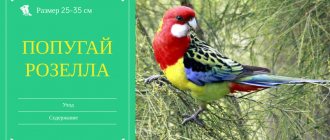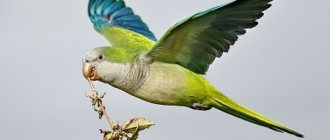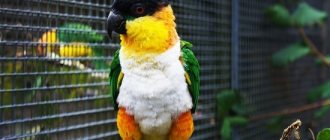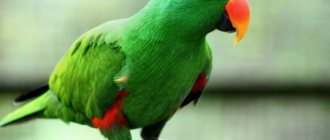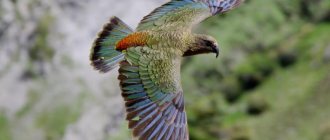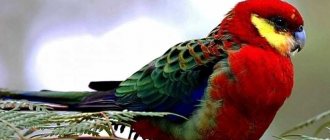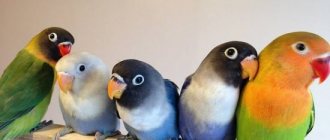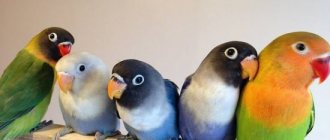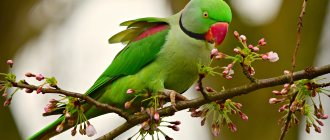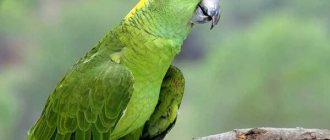The Senegal parrot is an amazing bird, unique and unpredictable. Getting a Senegalese is like playing the lottery: whether you get lucky or not. If you come across a hand-fed one, there will be less hassle with him and more emotional return. It is much more difficult with wild specimens brought in by smuggling. Such birds need a serious approach. Let's get to know this extraordinary representative of the parrot family better: what it looks like, where it lives, how long it can live. Let's find out the details of keeping and breeding a Senegal parrot at home.
Appearance
Senegalese are considered medium-sized parrots, as they grow up to 22-25 cm and gain body weight of about 170 g. However, due to their strong physique, they look impressive. The look of yellow eyes framed by black circles gives a special severity.
The main color of the plumage is green, this is how the wings, neck with “tie”, “breeches” and the outer part of the tail are colored. There is a yellow or orange “vest” on the abdomen. The head is dark gray, the cheeks are pearly. The paws are pink with a gray tint. The strong black beak is widened at the base and curves inward at the tip.
Senegal parrot
Bronzewing
Senegalese
Senegalese chicks
Handmade Senegalese
Of the huge number of birds inhabiting Africa, parrots have long been of particular interest to people. One of these is the Senegal parrot. People have been keeping these beautiful and intelligent birds at home for a long time, primarily because they have an amazing ability to reproduce human speech.
They are very smart, easy to train, real “child prodigies.” Senegal parrots raised at home become very attached to their owner. And given that the life expectancy of parrots is compatible with the life expectancy of humans, they often become full members of families, some of them sometimes live up to 50 years. They are Senegalese because they were first brought to Europe from Senegal. In general, these birds inhabit a significant territory of Africa, its entire western and southwestern parts.
Senegal parrots are not the largest. The body length is 2-25 cm, and the tail length is 10 cm. The legs are pink with green “pants”. The tail, wings and upper body are green, the lower abdomen is yellow or orange with a green wedge-shaped triangle. Up to a year old, their abdomen is lemon-yellow. The head is dark gray with a large black-gray beak.
Females have lighter head plumage and a smaller beak. Juvenile parrots have dark red irises while adults have yellow irises. Up to six months, young individuals have black eyes, ash-gray cheeks and a dark gray head color. According to color, there are three subspecies of Senegal parrots: the long-winged parrot, its color is light green; Finch's long-winged parrot is dark green with an orange belly, and Reikhenov's parrot has a greenish wedge on its chest right up to its belly.
Under natural conditions, the Senegal parrot lives in tree hollows or their crowns. It feeds on flowers and fruits of trees. Sometimes it ruins farms with grain crops. Might even catch a small lizard or mouse. Young parrots in the wild always build a nest next to their parents. Therefore, it is believed that Senegal parrots live in numerous colonies. Sometimes you can find colonies in which up to three thousand birds live.
Senegal parrots have been domesticated for a very long time. But in our country they began to appear relatively recently. The main reason for this was not that they can remember and reproduce human speech, but that they are very capable of learning to perform various tricks. With quite a bit of effort from their trainers, they easily become excellent circus performers. Even at home, it is not difficult to teach a parrot some gymnastic or acrobatic tricks.
Adult birds that are wanted to be domesticated are quite difficult to tame and are sometimes aggressive. They express their aggression with a loud cry and can bite. Most often this manifests itself during the period of defense of its territory, during the breeding season, the inability to fly away in case of danger, aggression or fear.
But the young quickly adapt and become tame. In captivity, he learns about 10 - 15 words, and even small phrases. Can happily perform some light tricks. It conveys intonation in conversation very well. Although he may not pronounce words clearly. The Senegal parrot has a quiet voice. The bird gladly shows off all its skills in front of guests. Gets attached to its owners.
Each member of the household is treated differently. Does not want to share the chosen owner with anyone. Therefore, it is easier to tolerate loneliness than company with other parrots. But he is sociable with everyone at home. He gets along especially well with children and other pets, even cats, dogs or rodents.
To keep a Senegal parrot at home, you need to have a spacious cage with thick perches. On it the parrot grinds down its claws and beak. In addition, he must fly freely at least once a week. Therefore, you need to install several comfortable perches indoors in different places. Senegal parrots like to sleep at least 10 hours a day. The cage should not be left overnight in a bright place. This prevents him from falling asleep. But if you have open windows, then carefully monitor the locks of the cage. Latches or hooks will not work here, because this cunning bird can easily unlock any lock.
Senegal parrots eat almost everything. But most of all, parrots love nuts, young branches, fruits, grains, herbs, seeds, vegetables and various berries. Boiled corn, muesli, and sprouted grains are also good to eat. They enjoy drinking birch sap. Grain food for a parrot can be easily found in any specialty store. But it is better to exclude bread, canned food, cheese, nuts, fried, spicy and fatty foods from the bird’s diet. Since some houseplants are poisonous, do not allow your parrot to try the leaves of indoor flowers.
Next to the feeder you should place a container with small pebbles or coarse sand. This will help the bird fully digest the food. It is advisable to have a bath in the cage for bathing the bird. After all, this species loves to swim. Swings, toys and perches placed in the cage will help keep your pet entertained while you're away from home.
They begin to reproduce after two years of age. The mating season for the Senegal parrot occurs in the spring. At this time, the male raises the feathers on the back of his head and his wings above his back. Courtship is accompanied by characteristic sounds. All this resembles a kind of dance. Females respond by trying to fluff up their tails. Then they look for a place to lay eggs. From 3 to 5 eggs are laid in the nest. The female incubates them for 22-24 days. All this time the male feeds the female and protects the nest from enemies. The chicks become independent after 11 weeks.
However, these parrots rarely breed at home. After all, it is very difficult to find a mate for your pet. If you select a pair, then install a nesting box in the cage with dimensions of 20/30/40 cm, in which the female will lay eggs. But keep in mind that breeding parrots is a rather labor-intensive process and also requires special knowledge and skills. And for normal keeping of a parrot at home, you only need a little attention and minimal care. So if you decide to have this wonderful bird in your home, we hope that the information in this short review will help you, and your parrot will bring joy to you and your household.
Habitat
The natural range of the Senegal parrot is a small area in western Africa from Senegal to Nigeria. Typical habitats are savannas, woodlands, grassy plains with shrubs. Parrots of this species are also found on hills up to 1000 m above sea level. Birds form flocks and move across vast territories in search of food. Senegalese often prey on agricultural fruits: corn, cereals, groundnuts. Because of this, parrots are considered pests.
During nesting, the flock does not split up; pairs are formed within it, which settle in hollows and tree crowns. The offspring grows and becomes stronger in the nest, and having learned to fly, they join the general flock, replenishing the colony of thousands.
Features of behavior
Due to the parrot's selective attitude towards family members and animals, special attention must be paid to its upbringing. In order for your Senegal to be tolerant of other people, from the first days of his stay in the house, involve your loved ones in caring for him. To socialize your bird, invite friends or acquaintances over more often. This way you will avoid your pet’s aggression towards guests in the future. And yet this species is attached to only one person. He will not show affection or play with anyone else.
Capabilities
Senegalese parrots love to play, they can even perform complex acrobatic acts, a large number of commands. The most talented individuals repeat a dozen simple words, but reproduce them unclearly, often in a language understandable only to the owner. But birds are much better able to imitate melodies, barking, creaking doors or the noise of household appliances. Exercise your pet every day for at least 40 minutes, then he will surprise you with his talents more than once.
Senegal parrot training
Description and photos of subspecies
Senegal in the classification belongs to the genus of parakeets. The species is divided into three subspecies:
- nominative (Senegalese longwing);
- Reichenova's Senegalese parrot;
- Finch's Senegal parrot.
Let’s take a closer look at how they are similar and how they differ from each other using photos.
Senegal parakeet
Senegalus is the nominate subspecies of the Senegalese parakeet. It was first discovered in 1766 by traveler and naturalist Carl Linnaeus. Distributed in Senegal, Guinea, Mauritania.
Nominative subspecies
The standard Senegalese has bright yellow belly plumage. The remaining areas of the body are painted in grassy green shades. The head is gray with a black tint.
Finch's Senegal parakeet
Versteri - Finch's parrot is named after the German ornithologist Otto Finsch, who studied this subspecies in 1863. The birds live in Nigeria, Ghana, and Ivory Coast. Representatives of this variety are darker in color than the nominative ones. The green mass of feathers has an olive tint, the vest is bright orange with a transition to red.
Finch's parrot
Reichenow's Senegalese parakeet
Mesotypus - Reichenow's parrot received its name thanks to the works of a German scientist who identified this subspecies in 1910. The habitat of the Senegalese Reichenow parrot is African countries such as Cameroon, Chad, Nigeria. The birds have a brighter belly than representatives of the standard species, but the green shades are much softer, closer to light green.
Reichenova's parrot
From this we can conclude that all three varieties of Senegal parrots have much in common, and their distinctive features are the richness of color and habitat.
How do they live in the wild?
These parrots are common in the western part of the African continent. In countries such as:
- Nigeria;
- Senegal;
- Mauritania;
- Gambia;
- Ghana and others.
They live in forests and grassy areas with sparse shrubs. They live at an altitude of up to 900 meters from ocean level. They eat flowers, berries, fruits. They are local farm pests because they feed on cereals.
Nests are made in found hollows. The male attracts the female by dancing. With raised wings and all disheveled, he makes peculiar sounds.
Abilities and character
Feathered natives of Africa have extraordinary intelligence and are easy to train. They easily learn simple tricks and demonstrate them without fail: they sort play equipment by shape and color, put different objects into each other, throw a ball into a hoop, and serve things to the owner at his request. Many people can recognize words and match them with commands.
The Senegalese are good at onomatopoeia: imitating voices, tapping, clicking, squealing, creaking. But these birds have difficulty repeating human words - they remember no more than a dozen words.
The following epithets apply to Senegalese parrots: rebellious, infinitely brave, cunning, jealous, charismatic. Representatives of the species strive to dominate even over the owner. They are not afraid of cats, dogs, or other birds. When letting your pet out for a walk, you need to remove children and pets from the room, otherwise both of them may get hurt. The parrot has a powerful, dangerous beak and claws and uses them for their intended purpose, without sparing the enemy.
Senegal chooses one owner, and treats the rest of the family as empty space. It is necessary to educate the ward from infancy so that there are no problems in the future.
Health and life expectancy
Under natural conditions, birds live 25-30 years, proximity to people extends life to 50. People protect the pet from encounters with predators, take care of its health and feed it with high-quality food.
A healthy Senegal parrot can be easily recognized by the following parameters:
- bright and clean plumage;
- shiny eyes, without accumulation of mucus;
- there is no dried feces under the tail;
- paws without scratches and with a full set of claws;
- smooth beak surface.
Activity and cheerfulness are the main signs of a healthy bird. Senegalese always wait for their owner to appear, they love to play and snack on an apple together. But you should remember that birds are very jealous. Aggression towards others will not manifest itself if you pay attention to the parrot and let it out of the cage.
Keeping at home
As a pet, the Senegal parrot is less common than small parrots. This is due to the fact that the exotic bird is quite expensive and is also famous for its aggressive nature. If you really want to have an unusual bird, you need to carefully prepare for its reception. Most difficulties can be avoided if the Senegal has spacious housing, good food and free range.
Arrangement of the cage
A reliable and safe large cage is the first thing your parrot will need at its new place of residence. But before buying a cage, you need to choose a place in the apartment where it will stand. It is necessary to position the future home in such a way as to avoid exposure to direct sunlight and drafts. The proximity of household appliances is also undesirable. You cannot install the cage in the kitchen, as the bird will not be able to fully rest in this room.
For a medium-sized parrot, a cage with a bottom of 80x100 cm and a height of 80 cm or more is suitable. The rods must be made of uncoated stainless steel, with a diameter of at least 4 mm. It is preferable not to have a rounded cage, but a rectangular one, so that the bird can hide in the corner if necessary. One side of the cage should be adjacent to the wall - this way the parrot can feel safe.
Filling the cage with various equipment is a prerequisite for preparation before purchasing a pet. Senegalese are strong and stocky, they love to climb ropes, ladders, and hang upside down. These devices must be securely fixed inside the cage. The same can be said about additives. You need to choose perches made of natural wood, or even better, make them yourself from branches of fruit trees. A homemade perch has the correct shape: its diameter increases from the extreme point of the branch to its beginning. The Senegal parrot will be able to sit in the area where it is most convenient at the moment.
Attention! A very important detail in the cage is the lock on the door. An ordinary hook or latch will not work, because the Senegalese open them only once or twice. Make sure that the bird does not get out of the cage in your absence.
Nutrition
Senegal parrots are famous for their good appetite and fast metabolism. The best food for them is cereals and seeds. You can create a diet for your pet yourself or buy a mixture for medium-sized parrots. The assorted grains must contain the following components:
- hemp seed;
- sunflower;
- canary seed;
- flax-seed;
- nuts (hazelnuts, pine, Brazilian);
- pumpkin seeds.
This is the main mixture that birds consume in dry form. In addition to it, Senegalese people need soaked cereals and cereals: wheat, barley, buckwheat, oats, millet. When hydrated, these ingredients have better digestibility and nutritional value.
In addition to grain, Senegalese, like other parrots, require succulent food. These are fruits, vegetables, greens.
On a note! Senegal parrots have a passion for certain fruits: they choose one thing and demand it every day. If you give them a fruit salad, the cunning birds will peck off the most delicious pieces and scatter the rest.
Products that are contraindicated for Senegalese:
- bread;
- confectionery;
- smoked meats;
- salo;
- garlic;
- onion;
- celery.
You cannot feed a parrot from your plate, because food for people contains components that are dangerous to birds. Salt, sugar, spices, sauces, drinks and much more are prohibited in the Senegalese diet.
Swimming and walking
One of the Senegal parrot's favorite activities is bathing. These birds happily jump into water, be it a filled pan, a special bathing tub, or a sink with an open tap. Without water treatments, African parrots suffer physically: moisture is necessary for feather growth. If the humidity in the room is low, the bird tolerates molting worse, constantly itches and pulls out feathers.
Sometimes the bird refuses to bathe. In such a situation, it is important to offer the parrot an alternative: spray it with a spray bottle, only carefully - this can cause fear and aggression. It is difficult to “negotiate” with Senegal parrots, but you should never force them to do anything. A simple way out is to secure a plastic bathing suit inside the cage. In this case, you do not have to let the bird out of the cage for a bath; it will choose the time for washing and entertainment.
Walking a parrot every day is a difficult undertaking. However, you should not keep your ward locked up all the time. The Senegalese's strong body needs movement. Even a spacious cage will not provide the necessary minimum for the development of muscles and joints. The bird needs to get out of the cage at least twice a week and walk and fly around the room for 1-2 hours. At this time, the owner must be nearby so that the pet does not do anything.
Feed and water
The standard Senegalese diet includes:
- ready-made grain mixtures for birds;
- fruits and vegetables;
- greens – dill, parsley;
- branches of trees or shrubs.
It should be remembered that birds are not recommended to be given chilled food or water. Even in hot weather, the water temperature should be at least 20 degrees, otherwise the pet will catch a cold.
Products prohibited for parrots include:
- food of animal origin: meat, fish, milk and dairy products;
- bakery;
- sweets.
As a protein supplement, a small amount of boiled eggs or cottage cheese is used once a week. It is also necessary to keep mineral stones or a mineral mixture (for example, shell rock) in the cage to maintain the necessary supply of nutrients in the bird’s body.
Before you treat your pet to something tasty and unusual, you should read reviews from Senegal owners to understand how the bird will perceive the new product.
Senegal parrots enjoy alcohol. Even in nature, they sometimes gain access to it - when they feed on fermented fruits. However, you should not offer alcoholic drinks to your pet - this will not bring any benefit.
Rules for choosing when purchasing and price
If you are concerned about purchasing such an original and rare pet, do not look for it in private advertisements. By contacting sellers on websites, you risk getting a sick bird, an adult instead of a chick, and one unsuitable for home keeping. In a similar way, unscrupulous breeders sell parrots that they could not tame and raise.
On a note! The right way to find a Senegal is a nursery with a good reputation. Even if there is no foster chick available, a professional breeder can accept orders for the next litter.
How to choose the right parrot? The general rules apply here:
- clear, clean eyes;
- dense plumage, uniform throughout the body;
- healthy paws without peeling;
- no signs of itching, discharge from the beak, nostrils and cloaca;
- presence of a ring on the foot.
A low price is an indicator of a low-quality product. The rare, difficult to breed Senegalese parakeet simply cannot be cheap. Even on online sites you cannot find a price below 20 thousand rubles. A chick from a nursery is valued at an average of 50-70 thousand rubles.
Cage requirement
Dimensions
The parrot's home should be quite spacious. Provided that the bird will fly around the room every day, you can limit yourself to a cage of 80x90x80cm. If you are keeping a pair of birds for breeding, it is advisable to place them in an aviary.
Feeder
With its powerful beak, the pet can easily break a plastic product. Therefore, you need to purchase two or three metal bowls for different types of food for the bird.
Drinking bowl
It is better to choose an automatic drinking bowl, since the water in it is less contaminated and will not splash out to the bottom of the cage. Change the drink daily, and also thoroughly wash the container itself.
Bath
Senegalese people love water treatments. You can install a bathing suit in the cage or regularly spray your pet with a spray bottle. Some birds prefer to expose their body parts to warm running water from a tap or shower.
Bath in a cage for a Senegal parrot
Perches
The branches of fruit trees are suitable as them. Before placing them in the cage, inspect for pests and cut off any sharp branches. The bark is left as a valuable source of trace elements. The perches are placed at different levels so that the bird can fly from one to another, and at the same time it has a place to turn around.
Mineral stone
Not required, but recommended by experienced breeders for a cage item. And although special feeding can be a source of minerals, sepia performs another important function - grinding down the beak. In addition, it is much more convenient for medium and large species of birds to gnaw on a mineral stone than to peck at a loose fine mixture.
Toys
The Senegal parakeet is an intelligent, cheerful bird. To develop intelligence and so that he does not get bored alone, buy more interesting things for entertainment.
Cage toys for parrots
It can be:
- cotton fiber ropes;
- swing;
- mirror;
- various puzzles;
- balls;
- rope ladders;
- rings;
- colorful cubes and pyramids.
You can buy toys at a pet store or make your own. It is better if they are made from natural materials. You should not give the bird everything at once; it is advisable to change them to maintain interest. It would be good if you set up a special stand next to the house.
How to determine the sex and age of a Senegal parrot
Senegalese have no pronounced sexual dimorphism. It is very difficult to determine by external signs where the female is and where the male is. If you compare a female and a male sitting next to each other, you can find some differences. It is believed that females are inferior to males in size and body weight. The boy's head is darker and more voluminous, his beak is thicker. In fact, you can find out the sex of a bird by its behavior. When parrots mature to breed, they behave differently: females are submissive and males are dominant.
Finding out the age of a parrot is a little easier. The main feature is eye color. Chicks have completely black eyes until they are six months old; later, reddish rims appear around the pupils. The older the bird, the lighter and wider the iris of its eyes.
How to choose and where is the best place to buy
You can buy Senegal from a private individual or in a nursery. If you buy from hand, there will be no documents and it can be difficult to determine the state of health.
It is better to buy from an official nursery with a positive reputation and good reviews from the owners . The most suitable option would be to purchase a baby under 6 months of age. This parrot quickly makes contact, is affectionate and trusting.
If you get an already adult individual that has had an owner, then it takes a lot of effort and time to accustom him and re-educate him.
When choosing a friend, you need to pay attention to his appearance. A healthy parrot is cheerful, active, with dense plumage. The eyes are clear, there are no abscesses around them. Paws without wounds or scratches.
Such a bird costs from $300 to $800.
Breeding
At home, getting offspring from Senegalese fosterlings is not easy, but it is possible. Wild individuals are more suitable for breeding; they have a better developed instinct for procreation. You need to select a pair from birds that are not related, and they should be close in age. Senegal parrots can breed from the age of three.
You can wait until the birds' instincts take over, or you can push the pets to start nesting. To do this, several conditions must be met:
- Increase daylight hours to 12-14 hours.
- Supplement the birds with protein foods (cottage cheese, eggs, insects) and soaked grain.
- Install a nesting house (box, nest) in the cage.
Senegal parrot chick
Readiness for reproduction is determined in birds by their behavior. The male demonstrates his talents to the female: he dances, sings, puffs up his feathers and courtes in every possible way. The sounds made by a flirting male are unpleasant to the human ear. At the end of mating games, the female lays 5-6 eggs in the nest and incubates them for 22-27 days. It is difficult for parents to feed all newborn chicks, so the breeder takes the week-old cubs for additional feeding. After 2 months, the chicks become externally similar to adults and begin to fly.
When planning to get a Senegal parrot, you need to weigh the pros and cons. This is a wayward pet, difficult to tame, and quite aggressive. Senegal is very talented, he can compete with other feathered intellectuals. You always need to be on guard with him, but if you're lucky, the bird will become a devoted comrade.
Can they live at home?
These parrots have been domesticated for a long time. However, they have a wayward character and require training. With proper care, feeding, and development, Senegals easily adapt to their home environment and get used to people.
There is a lot of literature on keeping these birds. Before getting a pet, you need to study it. Then there will be no difficulties with arranging the parrot’s personal space.
In order for your pet to be socialized, you need to do a lot with it and invite friends to your house more often. Otherwise, he will be aggressive and create a lot of problems for the owner.
Chicks get used to a new person better. Adults that have already had an owner remain stressed for a long time. Problems may arise with other pets. You need to be able to resolve such conflicts.
The importance of where to purchase your future parrot
You can purchase a wild Senegal parrot, a hatchling from a nursery from a trusted breeder, or a resold bird. The age, health of the parrot and its background play an important role. If it is a young chick, then you can correct the bird’s character through upbringing, but if an adult bird comes to you, the process will be longer, but most often with a positive result. It is not always possible to purchase a Senegal, following all the purchasing rules; sometimes you come across unscrupulous sellers, or the situation is such that you have to save the bird.
The wild Senegal parakeet is timid and mistrustful; enormous patience must be shown in taming such a bird. They are reluctant to make contact, but it is believed that wild Senegal parrots, unlike domestic ones, are more loyal to their neighbors. As for the “foster” from the nursery, there are no problems with taming, the bird is initially affectionate, like a kitten, and will strive in every possible way to spend as much time as possible with you. If only one person takes part in the upbringing, then the parrot’s contact with other people will be impossible. In the company of other people, Senegal will turn from an affectionate and restless parrot into an aggressive bird that attacks everyone.
Photo: Bram Cymet
This overbought Senegal, whose age is difficult to determine, needs a lot of attention and care. It’s a good idea to find out about his past life: in what conditions he lived, what he ate, what his name was. If the Senegal parrot's stress does not go away after moving to a new home, and you understand that the problem is with the previous owner, change the bird's name, try to protect it from sounds and objects that cause it to panic. Call him by a new affectionate name more often - this will strengthen your relationship. If you got a parrot that previously lived in a loving family, then recreate the familiar atmosphere for the bird as much as possible. Treat her to her favorite treat, place familiar toys in her cage, and gradually introduce something new.
Care and maintenance
Before buying a parrot, you need to study the required living conditions so that the pet feels comfortable and you do not waste time and money on visiting the veterinarian.
Selection and arrangement of the cage
Cell . The minimum dimensions are 80x90x80 cm. It is better if the cage is rectangular. It is also worth taking care of the complexity of the mechanism that is used to lock the cage, since the Senegalese are smart and can easily cope with hooks, latches, nuts and the like.
Feeder. Any feeder for large parrots will do. Most often, cages are sold with a built-in feeder, so there is no need to buy anything additional. It is necessary to allocate an additional feeder in which small pebbles are placed. The pet uses them to grind food.
Drinking bowl . A large drinking bowl is used, which is suspended from the outside. It is recommended to secure it well with wire so that the parrot cannot unhook it and overturn it, leaving itself without water.
Important! The drinking bowl and feeder should be metal or wooden. Plastic will quickly become unusable.
Bath. Parrots of this breed love water treatments, so a small metal bath with warm water is installed in the cage. It is important that the bird cannot turn it over, otherwise the bedding will have to be changed several times a day.
Perches . The number of perches should be moderate so that the bird has room to turn around. The diameter should be such that the pet can sit comfortably. It is not recommended to buy too thin perches or use soft wood as a material.
Mineral stone . Necessary for birds to grind down their claws and beak. Small twigs and tree bark can be used to replace the stone.
Toys. Be sure to buy your pet a mirror, a small swing, and also hang ropes. All items must withstand the force of beaks and claws, so it is better to avoid plastic products.
Conditions of detention
Lighting . Parrots need to sleep about 10 hours a day, so the daylight hours should be close to 14 hours. In the warm season, you don’t have to limit natural light, but in winter, additional lighting is definitely required. However, the bird gets enough light from an ordinary light bulb in the room.
Temperature. Senegalese cannot tolerate low temperatures, so the room must always be warm. The optimal air temperature is +18…+30 °C. Sudden changes, drafts, and significant decreases in humidity should not be allowed.
Walking . Your pet cannot be kept in a cage all the time; he must spread his wings and fly around the room at least once a day. The exception is the period of adaptation, when the parrot does not yet perceive you as an owner or friend.
To prevent the bird from damaging the furniture, it is recommended to place perches and any toys that may interest the Senegalese in the corners of the room.
Cleaning the cage
Every day they clean the feeder from food debris, change the water in the drinking bowl and in the bath. You should also remove excrement from perches and toys to prevent them from absorbing unpleasant odors.
As it gets dirty, the bedding is changed, and complete disinfection is carried out once a month or based on the recommendations of a veterinarian if the parrot is sick with something.
